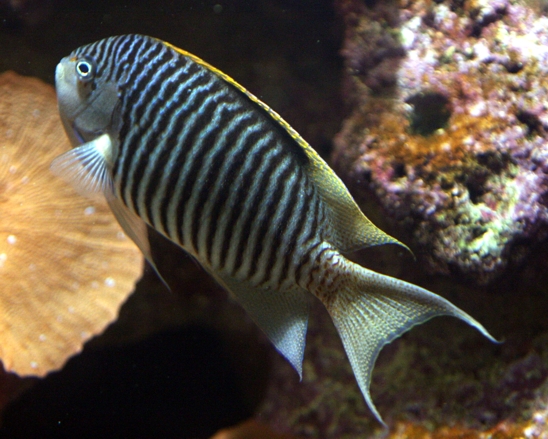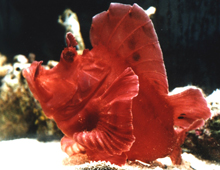Sri Lanka

Zebra angelfish, Genicanthus caudovittatus
In contrast to many other angelfish, which live in pairs, swallowtail angels, in the genus Genicanthus live like fairy basslets, with a dominant male guarding a harem of females. As with fairy basslets, if the male dies, the dominant female will become male and take charge of the harem. This species is found only in the Red Sea and the Western Indian Ocean. Only the male has the zebra pattern but only the female has the black stripes at the top and bottom of the tail, commemorated by the Latin name “caudovitatu”, which means “striped tail”.
LEARN MORE
Colt coral, Cladiella sp.
The Colt coral is a soft, branching coral that is found in Indo-Pacific coral reefs. It does not have the calcium carbonate skeleton of the reef building corals. It is a hardy aquarium species and is commonly cultured. Like other corals, its tissues are home to photosynthetic algae known as zooxanthellae which provide the coral with oxygen and nutrients.
LEARN MORE
Red mushroom anemone, Actinodiscus sp.
The Red mushroom anemone is also known as Mushroom coral or Disc anemones. They can vary in shade from red to pink or purple and are a hardy aquarium species. Symbiotic algae, known as zooxanthellae, are responsible for the red color and also provide the coral with nutrients and oxygen. These corals readily reproduce in an aquarium by a cloning process known as budding.
LEARN MORE
Carberryi anthias, Nemanthias carberryi
Like other fairy basslets, the Carberryi or Threadfin anthias lives in small schools composed of a dominant male and his harem of females. This species is found only in the Indian Ocean. It was described for science in 1954, one of 370 new fish species named by the famous South African ichthyologist J.L.B. Smith, who rediscovered the Coelacanth.
LEARN MORE
Moorish idol, Zanclus cornutus
Like toucans and macaws, this fish has become a quintessential symbol of the Tropics, appearing as all sorts of kitschy souvenirs and “decorations”. It is often seen on postcards from Florida (where it is not found!). It is also familiar as “Gill”, in the Disney / Pixar movie, “Finding Nemo”. Because its tiny larvae travel well in plankton, it is found all the way from the East Africa, clear across the Indian Ocean and Pacific, to the west coast of Mexico, south to Peru. It is closely related to tangs and surgeonfish, but lacks their “scalpel”.
LEARN MORE
Gem tang, Zebrasoma gemmatum
Many of the 80 or so members of the tang and surgeonfish family have wide ranges across tropical seas, but this uniquely spotted species is restricted to Madagascar, the nearby East African Coast, and the Mascarene Islands. As few fishes are exported from these places, it has seldom been seen in public aquariums.
LEARN MORE
Eschmeyer’s scorpionfish, Rhinopias eschmeyeri
Scorpionfish, in general, are notorious for the venomous spines which give them their family name. The six members of the genus Rhinopias stand out for their magnificently bizarre appearance. Their story-book dragon faces, ornate fins, and peculiar under-water waddle, make them fascinating. This species, from the Indian Ocean and Indo-Pacific, was unknown to science until 1977, when it was named to honor the American authority on scorpionfish, who described two other new Rhinopias species in 1973.
LEARN MORE

